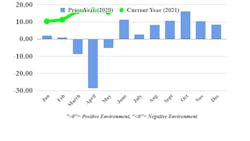FTR’s Trucking Conditions Index (TCI) for May eased slightly from the April record reading (16.82) to a still-robust 15.72.
Stronger freight rates would have pushed the index to a third straight record, but a swing in diesel prices from a slight positive in April to a negative in May, along with slightly weaker capacity utilization, offset those gains. The TCI is forecast to remain at double-digit positive readings through 2021 and stay positive through 2022.
However, this outlook depends on only incremental improvement in driver capacity in the near term.
Details of the May TCI are found in the July issue of FTR’s Trucking Update, published June 30, which includes details on how a recent revision in historical industrial production data affects FTR’s truck freight volume forecasts.
“Market conditions in the flatbed segment appear to be stabilizing, but we do not have clear signs of the stress in the van markets easing,” said Avery Vise, FTR’s vice president of trucking. “The solid increase in for-hire trucking’s payroll employment during June might be a hint that the market is peaking, but we expect considerable friction to remain in the supply of drivers at least into next year.
“However, one of the market stresses has been the unprecedented surge in small new trucking operations, which has added to market disruptions. With high diesel prices and truck insurance costs, we would expect many of those drivers to return to the security of larger employers once spot rates start falling significantly. This possibility, along with the end of generous unemployment benefits, represents risks in the outlook.”
The TCI tracks the changes representing five major conditions in the U.S. truck market: freight volumes, freight rates, fleet capacity, fuel price, and financing. The individual metrics are combined into a single index indicating the industry’s overall health. A positive score represents good, optimistic conditions. Conversely, a negative score represents bad, pessimistic conditions. Readings near zero are consistent with a neutral operating environment, and double-digit readings in either direction suggest significant operating changes are likely.
